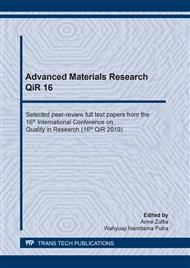p.272
p.278
p.285
p.293
p.303
p.311
p.318
p.324
p.331
Adsorption of CO Gas and Cigarette Smoke Using NiO-Modified Metal Activated Carbon
Abstract:
Smoking can cause various ongoing complications in the body. One of the dangerous components of cigarette smoke is carbon monoxide which is one of the most toxic pollutants produced from cigarette gas emissions. Reducing levels in the air can utilize the adsorbent in the form of activated carbon which has the capacity and selectivity to these pollutants. Activated carbon was prepared from corn stalks which were activated by KOH at 750 °C based on previous research. The activated carbon which produced have Iodine number equal to 602 mg/g and SBET reached 599 m2/g. To strengthen the adsorption power, the results of activated carbon will be modified by impregnation of NiO metal. Metal impregnation varied with loading percentage 0.5, 1 and 2%. Modified activated carbons were then characterized by the Iodine Number test, BET test, SEM test, and EDX test. Each of the modified activated carbon will be tested for the capacity and selectivity of adsorption of CO and cigarette smoke. The best modified activated carbon is Mod 0.5% with Iodine number equal to 844 mg/g and SBET reached 839 m2/g. The best adsorption ability is obtained by 0.5% NiO-modified activated carbon which able to reduce CO gas levels by 29.9% and for cigarette smoke reaching 82.16%.
Info:
Periodical:
Pages:
303-310
Citation:
Online since:
July 2020
Price:
Сopyright:
© 2020 Trans Tech Publications Ltd. All Rights Reserved
Share:
Citation:


